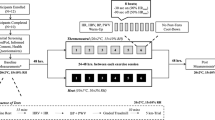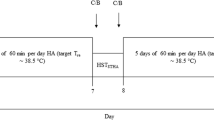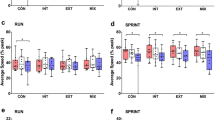Abstract
In this study, we investigated the metabolic and performance responses to hyperthermia during high-intensity exercise. Seven males completed two 30-s cycle sprints (SpI and SpII) at an environmental temperature of 20.6 (0.3) °C [mean (SD)] with 4 min recovery between sprints. A hot or control treatment preceded the sprint exercise. For the hot trial, subjects were immersed up to the neck in hot water [43°C for 16.0 (3.2) min] prior to entering an environmental chamber [44.2 (0.8)°C for 30.7 (7.1) min]. For the control trial, subjects were seated in an empty bath (15 min) and thereafter in a normal environment [20.2 (0.6)°C for 29.0 (1.9) min]. Subjects’ core temperature prior to exercise was 38.1 (0.3)°C in the hot trial and 37.1 (0.3)°C in the control trial. Mean power output (MPO) was significantly higher in the hot condition for SpI [683 (130) W hot vs 646 (119) W control (P<0.025)]. Peak power output (PPO) tended to be higher in the hot trial compared with the control trial for SpI [1057 (260) W hot vs 990 (245) W control (P=0.03, NS)]. These differences in power output were a consequence of a faster pedal cadence in the hot trial (P<0.025). There were no differences in sprint performance in SpII in the hot trial compared to the control trial; however, MPO was significantly reduced from SpI to SpII in the hot condition but not in the control condition (P<0.025). Plasma ammonia was higher in the hot trial at 2 min post-SpI [169 (65) μmol l-1 hot vs 70 (26) μmol l-1 control (P<0.01)], immediately and at 2 min post-SpII [231 (76) μmol l-1 hot vs 147 (72) μmol l-1 control (P<0.01)]. Blood lactate was higher in the hot trial compared with the control trial at 5 min post-SpII (P<0.025). The results of this study suggest that an elevation in core body temperature by 1°C can improve performance during an initial bout of high-intensity cycle exercise but has no further beneficial effect on subsequent power production following a 4-min recovery period.



Similar content being viewed by others
References
Backx K, McNaughton L, Crickmore L, Palmer G, Carlisle A (2000) Effects of differing heat and humidity on the performance and recovery from multiple high intensity, intermittent exercise bouts. Int J Sports Med 21:400–405
Ball D, Burrows C, Sargeant AJ (1999) Human power output during repeated sprint cycle exercise: the influence of thermal stress. Eur J Appl Physiol 79:360–366
Brenner IKM, Zamecnik J, Shek PN, Shephard RJ (1997) The impact of heat exposure and repeated exercise on circulating stress hormones. Eur J Appl Physiol 76:445–454
Bruck K, Olschewski H (1987) Body temperature related factors diminishing the drive to exercise. Can J Physiol Pharmacol 65:1274–1280
Cross MC (1996) The regulation of growth hormone secretion during different physiologic states: influence of physical activity, alpha-adrenergic blockade and core temperature clamping. Ph.D. thesis, University of Toronto
Davis GC, Kissinger PT, Shoup RE (1981) Strategies for determination of serum or plasma noradrenaline by reverse phase liquid chromatography. Anal Chem 53:156–159
Dill DB, Costill DL (1974) Calculation of percentage changes in volumes of blood, plasma, and red cells in dehydration. J Appl Physiol 37:247–249
Durnin JVGA, Womersley J (1974) Body fat assessed from total body density and its estimation from skinfold thickness: Measurements on 481 men and women aged 16 to 72 years. Br J Nutr 32:77–97
Edwards RHT, Harris RC, Hultman E, Kaijser L, Koh D, Nordesjo LO (1972) Effects of temperature on muscle energy metabolism and endurance during successive isometric contractions, sustained to fatigue, of the quadriceps muscle in man. J Physiol (Lond) 220:335–352
Falk B, Radom-Isaac S, Hoffmann JR, Wang Y, Yarom Y, Magazanik A, Weinstein Y (1998) The effect of heat exposure on performance of and recovery from high-intensity, intermittent exercise. Int J Sports Med 19:1–6
Febbraio MA, Snow RJ, Stathis CG, Hargreaves M, Carey MF (1994) Effect of heat stress on muscle energy metabolism during exercise. J Appl Physiol 77:2827–2831
Febbraio MA, Carey MF, Snow RJ, Stathis CG, Hargreaves M (1996) Influence of muscle temperature on metabolism during intense exercise. Am J Physiol 271:R1251–R1255
Fink WJ, Costill DL, Van Handel PJ (1975) Leg muscle metabolism in the heat and cold. Eur J Appl Physiol 34:183–190
Gonzalez-Alonso J, Teller C, Andersen SL, Jensen FB, Hyldig T, and Nielsen B (1999) Influence of body temperature on the development of fatigue during prolonged exercise in the heat. J Appl Physiol 86:1032–1039
Hargreaves M, Angus DJ, Howlett K, Marmy Conus M, Febbraio MA (1996) Effect of heat stress on glucose kinetics during exercise. J Appl Physiol 81:1584–1597
Lakomy HKA (1986) Measurement of work and power output using friction-loaded cycle ergometers. Ergonomics 29:509–517
MacDougal JD, Reddan WG, Layton CR, Dempsey JA (1974) Effects of hyperthermia on performance during heavy prolonged exercise. J Appl Physiol 36:538–544
Maughan RJ (1982) A simple, rapid method for the determination of glucose, lactate, pyruvate, alanine, 3-hydroxybutyrate and acetoacetate in a single 20μl blood sample. Clin Chim Acta 122:231–240
Melin B, Cure M, Pequignot JM, Bittel J (1988) Body temperature and plasma prolactin and norepinephrine relationships during exercise in a warm environment: effect of dehydration. Eur J Appl Physiol 58:146–151
Morris JG, Nevill ME, Williams C (2000) Physiological and metabolic responses of female games and endurance athletes to prolonged, intermittent, high-intensity running at 30° and 16°C ambient temperature. Eur J Appl Physiol 81:84–92
Nieslen B, Savard G, Richter EA, Hargreaves M, Saltin B (1990) Muscle blood flow and muscle metabolism during exercise and heat stress. J Appl Physiol 69:1040–1046
Nieslen B, Hales JRS, Strange S, Juel Christensen K, Warberg J, Saltin B (1993) Human circulatory and thermoregulatory adaptations to heat acclimation and exercise in a hot, dry environment. J Physiol (Lond) 460:467–485
Nybo L, Nielsen B (2001) Hyperthermia and central fatigue during prolonged exercise in humans. J Appl Physiol 91:1055–1060
Oyono-Enguelle S, Heitz A, Marbach J, Ott C, Pape A, Freund H (1993) Heat stress does not modify lactate exchange and removal abilities during recovery from short exercise. J Appl Physiol 74:1248–1255
Parkin JM, Carey MF, Zhao S, Febbraio MA (1999) Effect of ambient temperature on human skeletal muscle metabolism during fatiguing submaximal exercise. J Appl Physiol 86:902–908
Powers SK, Howley ET, Cox R (1982) A differential catecholamine response during prolonged exercise and passive heating. Med Sci Sports Exerc 14:435–439
Radomski MW, Cross M, Buguet A (1998) Exercise-induced hyperthermia and hormonal responses to exercise. Can J Physiol Pharmacol 76:547–552
Sargeant AJ (1987) Effect of muscle temperature on leg extension force and short-term power output in humans. Eur J Appl Physiol 56:693–698
Sargeant AJ, Rademaker A (1996) Human muscle power in the locomotory range of contraction velocities increases with temperature due to an increase in power generated by the type I fibres. J Physiol (Lond) 491:128P
Stanley DC, Kraemer WJ, Howard RL, Armstrong LE, Maresh CM (1994) The effects of hot water immersion on muscle strength. J Strength Cond Res 8:134–138
Tullson PC, Terjung RL (1991) Adenine nucleotide metabolism in contracting skeletal muscle. Exerc Sports Sci Rev 19:507–537
Author information
Authors and Affiliations
Corresponding author
Rights and permissions
About this article
Cite this article
Linnane, D.M., Bracken, R.M., Brooks, S. et al. Effects of hyperthermia on the metabolic responses to repeated high-intensity exercise. Eur J Appl Physiol 93, 159–166 (2004). https://doi.org/10.1007/s00421-004-1191-5
Accepted:
Published:
Issue Date:
DOI: https://doi.org/10.1007/s00421-004-1191-5




